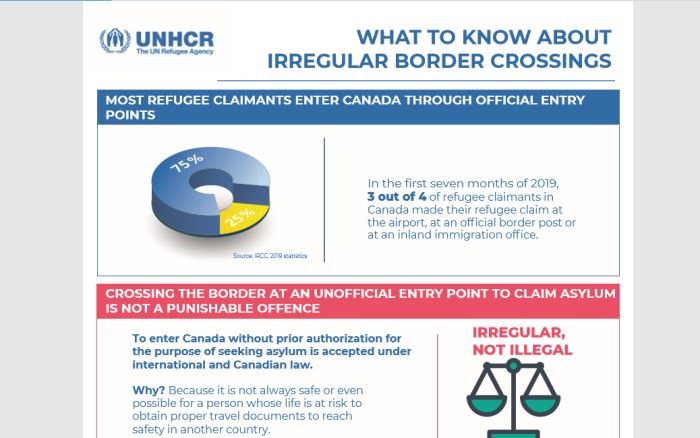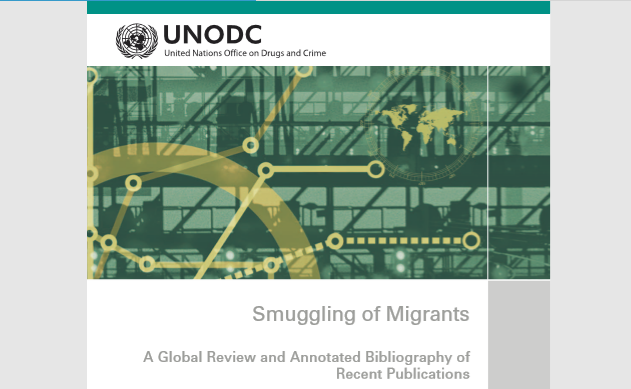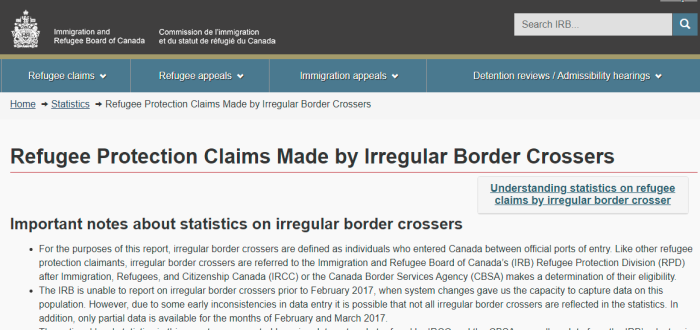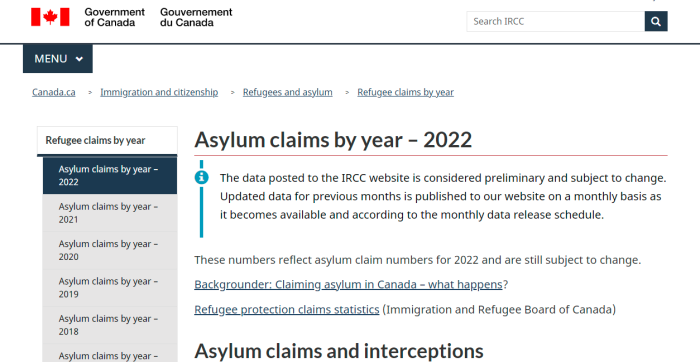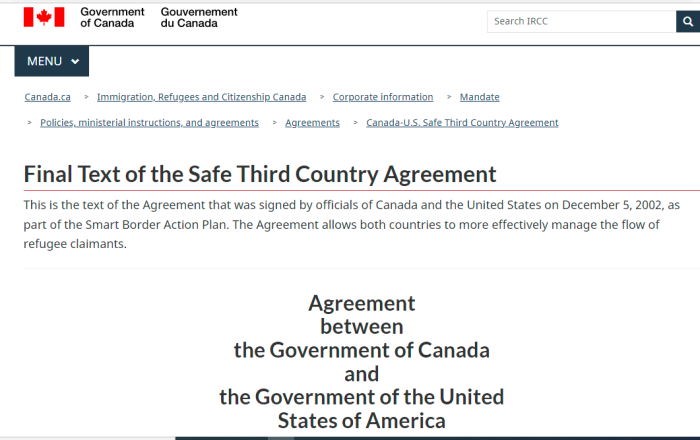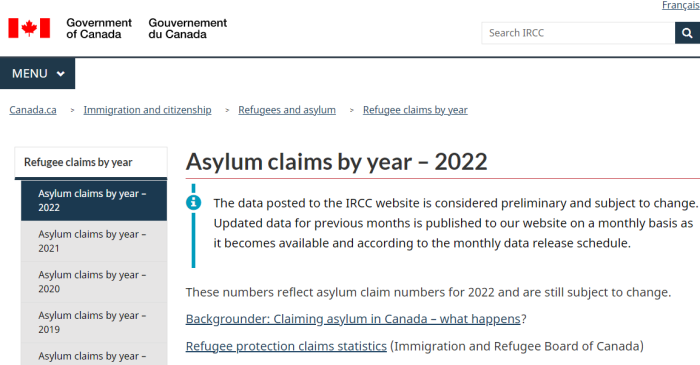
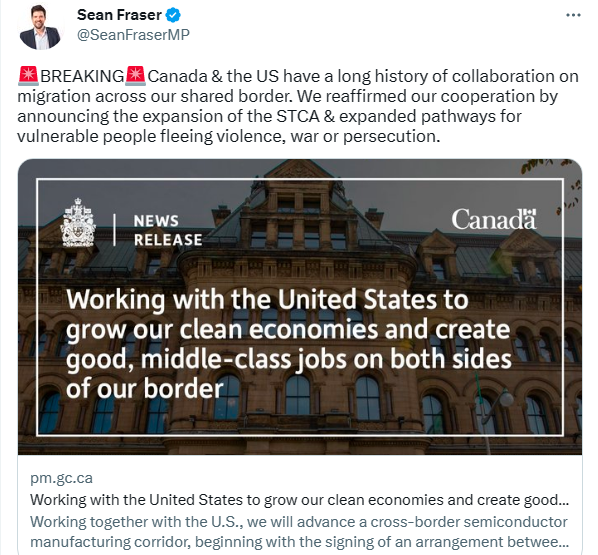
Starting on March 25th, people illegally entering Canada from the United States to claim asylum will no longer be able to bypass immediate deportation simply by crossing between ports. A new change is expected to apply the same standard regardless of where they cross.
However, it’s not anywhere near the “fix” that it’s being made out to be.
Sean Fraser, Minister of Immigration, spread the notice on Friday.
To address irregular migration, we are expanding the Safe Third Country Agreement to apply not only at designated ports of entry, but across the entire land border, including internal waterways, ensuring fairness and more orderly migration between our two countries. This change will come into effect at 12:01 A.M (EDT) on Saturday, March 25, 2023. Canada also announced we will welcome 15,000 migrants on a humanitarian basis from the Western Hemisphere over the course of the year, with a path to economic opportunities to address forced displacement, as an alternative to irregular migration.
Even if this were to be applied, and Roxham Road effectively closed, the Safe Third Country Agreement has a number of other loopholes built into it to ensure a steady stream of crossers. This applies to “refugees” fleeing from the United States. More on that later in the article.
And what are the numbers on people illegally crossing into Canada over the last several years? Keep in mind, these are just official statistics.
| PROVINCE/TERRITORY | 2011 | 2012 | 2013 | 2014 | 2015 | 2016 |
|---|---|---|---|---|---|---|
| Newfoundland | 0 | 0 | 0 | 0 | 0 | 0 |
| Prince Edward Island | 0 | 0 | 0 | 0 | 0 | 0 |
| Nova Scotia | 0 | 0 | 0 | 0 | 0 | 0 |
| New Brunswick | 10 | 5 | 5 | ? | ? | 25 |
| Quebec | 1,335 | 1,295 | 785 | 875 | 1,035 | 2,595 |
| Ontario | 2,660 | 2,340 | 1,995 | 2,630 | 2,790 | 3,7935 |
| Manitoba | 20 | 15 | 25 | 10 | 225 | 505 |
| Saskatchewan | ? | ? | ? | ? | ? | 30 |
| Alberta | 35 | 40 | 35 | 65 | 70 | 120 |
| British Columbia | 125 | 85 | 110 | 130 | 170 | 220 |
| Yukon | 0 | 0 | 0 | 0 | 0 | 5 |
| Northwest Territories | 0 | 0 | 0 | 0 | 0 | 0 |
| Nunavut | 0 | 0 | 0 | 0 | 0 | 0 |
| TOTALS | 4,185 | 3,770 | 2,955 | 3,715 | 4,290 | 7,365 |
Illegals were still coming into Canada via land border crossings during the Harper years. Interestingly though, it only receives major attention when Liberals are in power. A cynic may wonder why.
| YEAR: 2017 | |||||
|---|---|---|---|---|---|
| MONTH | QUEBEC | MANITOBA | B.C. | OTHERS | TOTAL |
| January | 245 | 19 | 46 | 5 | 315 |
| February | 452 | 142 | 84 | 0 | 678 |
| March | 654 | 170 | 71 | 2 | 897 |
| April | 672 | 146 | 32 | 9 | 859 |
| May | 576 | 106 | 60 | 0 | 742 |
| June | 781 | 63 | 39 | 1 | 884 |
| July | 2,996 | 87 | 51 | 0 | 3,314 |
| August | 5,530 | 80 | 102 | 0 | 5,712 |
| September | 1,720 | 78 | 79 | 4 | 1,881 |
| October | 1,755 | 67 | 68 | 8 | 1,890 |
| November | 1,539 | 38 | 46 | 0 | 1,623 |
| December | 1,916 | 22 | 40 | 0 | 1,978 |
| TOTAL | 18,836 | 1,018 | 718 | 22 | 20,593 |
| YEAR: 2018 | |||||
|---|---|---|---|---|---|
| MONTH | QUEBEC | MANITOBA | B.C. | OTHERS | TOTAL |
| January | 1,458 | 18 | 41 | 0 | 1,517 |
| February | 1,486 | 31 | 48 | 0 | 1,565 |
| March | 1,884 | 53 | 33 | 0 | 1,970 |
| April | 2,479 | 50 | 31 | 0 | 2,560 |
| May | 1,775 | 36 | 53 | 0 | 1,869 |
| June | 1,179 | 31 | 53 | 0 | 1,263 |
| July | 1,552 | 51 | 31 | 0 | 1,634 |
| August | 1,666 | 39 | 39 | 3 | 1,747 |
| September | 1,485 | 44 | 68 | 4 | 1,601 |
| October | 1,334 | 23 | 37 | 0 | 1,394 |
| November | 978 | 23 | 18 | 0 | 1,019 |
| December | 1,242 | 11 | 27 | 0 | 1,280 |
| TOTAL | 18,518 | 410 | 479 | 7 | 19,419 |
| YEAR: 2019 | |||||
|---|---|---|---|---|---|
| MONTH | QUEBEC | MANITOBA | B.C. | OTHERS | TOTAL |
| January | 871 | 1 | 16 | 1 | 888 |
| February | 800 | 1 | 6 | 2 | 808 |
| March | 967 | 13 | 22 | 0 | 1,002 |
| April | 1,206 | 15 | 25 | 0 | 1,246 |
| May | 1,149 | 27 | 20 | 0 | 1,196 |
| June | 1,536 | 26 | 5 | 0 | 1,567 |
| July | 1,835 | 23 | 15 | 1 | 1,874 |
| August | 1,712 | 26 | 22 | 2 | 1,762 |
| September | 1,706 | 19 | 17 | 0 | 1,737 |
| October | 1,595 | 18 | 8 | 1 | 1,622 |
| November | 1,118 | 9 | 21 | 0 | 1,148 |
| December | 1,646 | 2 | 5 | 2 | 1,653 |
| TOTAL | 16,136 | 180 | 182 | 9 | 16,503 |
| YEAR: 2020 | |||||
|---|---|---|---|---|---|
| MONTH | QUEBEC | MANITOBA | B.C. | OTHERS | TOTAL |
| January | 1,086 | 7 | 7 | 0 | 1,100 |
| February | 976 | 2 | 2 | 0 | 980 |
| March | 930 | 7 | 18 | 0 | 955 |
| April | 1 | 0 | 5 | 0 | 6 |
| May | 17 | 0 | 4 | 0 | 21 |
| June | 28 | 1 | 3 | 1 | 33 |
| July | 29 | 2 | 17 | 0 | 48 |
| August | 15 | 3 | 0 | 0 | 18 |
| September | 30 | 4 | 7 | 0 | 41 |
| October | 27 | 0 | 4 | 0 | 31 |
| November | 24 | 0 | 8 | 0 | 32 |
| December | 26 | 2 | 8 | 0 | 36 |
| TOTAL | 3,189 | 28 | 84 | 1 | 3,302 |
| YEAR: 2021 | |||||
|---|---|---|---|---|---|
| MONTH | QUEBEC | MANITOBA | B.C. | OTHERS | TOTAL |
| January | 28 | 1 | 10 | 0 | 39 |
| February | 39 | 0 | 1 | 0 | 40 |
| March | 29 | 5 | 2 | 0 | 36 |
| April | 29 | 2 | 2 | 0 | 33 |
| May | 12 | 3 | 13 | 0 | 28 |
| June | 11 | 0 | 6 | 0 | 17 |
| July | 28 | 5 | 6 | 0 | 39 |
| August | 63 | 2 | 11 | 0 | 76 |
| September | 150 | 0 | 19 | 0 | 169 |
| October | 96 | 0 | 17 | 0 | 113 |
| November | 832 | 1 | 12 | 0 | 845 |
| December | 2,778 | 0 | 33 | 0 | 2,811 |
| TOTAL | 4,095 | 19 | 132 | 0 | 4,246 |
| YEAR: 2022 | |||||
|---|---|---|---|---|---|
| MONTH | QUEBEC | MANITOBA | B.C. | OTHERS | TOTAL |
| January | 2,367 | 0 | 16 | 0 | 2,383 |
| February | 2,154 | 1 | 9 | 0 | 2,164 |
| March | 2,492 | 2 | 8 | 0 | 2,502 |
| April | 2,791 | 3 | 8 | 3 | 2,805 |
| May | 3,449 | 3 | 40 | 1 | 3,493 |
| June | 3,066 | 3 | 14 | 3 | 3,086 |
| July | 3,645 | 3 | 29 | 0 | 3,677 |
| August | 3,234 | 5 | 10 | 0 | 3,249 |
| September | 3,650 | 10 | 0 | 0 | 3,660 |
| October | 3,901 | 16 | 34 | 0 | 3,951 |
| November | 3,731 | 23 | 34 | 0 | 3,788 |
| December | 4,689 | 3 | 52 | 1 | 4,745 |
| TOTALS | 39,171 | 72 | 289 | 7 | 39,540 |
And of course, this has continued into 2023. This is because…. reasons.
| YEAR: 2023 | |||||
|---|---|---|---|---|---|
| MONTH | QUEBEC | MANITOBA | B.C. | OTHERS | TOTAL |
| January | 4,875 | 19 | 100 | 0 | 4,994 |
| February | 4,517 | 5 | 53 | 0 | 4,575 |
| TOTALS | 9,392 | 24 | 153 | 0 | 9,569 |
Keep in mind, there are a number of “exceptions” that will let people enter from the United States anyway. These include:
(1) Family member exceptions
Refugee claimants may qualify under this category of exceptions if they have a family member who:
- is a Canadian citizen
- is a permanent resident of Canada
- is a protected person under Canadian immigration legislation
- has made a claim for refugee status in Canada that has been accepted by the Immigration and Refugee Board of Canada (IRB)
- has had his or her removal order stayed on humanitarian and compassionate grounds
- holds a valid Canadian work permit
- holds a valid Canadian study permit, or
- is over 18 years old and has a claim for refugee protection that has been referred to the IRB for determination. (This claim must not have been withdrawn by the family member, declared abandoned or rejected by the IRB or found ineligible for referral to the IRB.)
(2) Unaccompanied minors exception
Refugee claimants may qualify under this category of exceptions if they are minors (under the age of 18) who:
- are not accompanied by their mother, father or legal guardian
- have neither a spouse nor a common-law partner, and
- do not have a mother, a father or a legal guardian in Canada or the United States.
(3) Document holder exceptions
Refugee claimants may qualify under this category of exceptions if they:
- hold a valid Canadian visa (other than a transit visa)
- hold a valid work permit
- hold a valid study permit
- hold a travel document (for permanent residents or refugees) or other valid admission document issued by Canada, or
- are not required (exempt) to get a temporary resident visa to enter Canada but require a U.S.–issued visa to enter the U.S.
(4) Public interest exceptions
Refugee claimants may qualify under this category of exceptions if:
- they have been charged with or convicted of an offence that could subject them to the death penalty in the U.S. or in a third country. However, a refugee claimant is ineligible if he or she has been found inadmissible in Canada on the grounds of security, for violating human or international rights, or for serious criminality, or if the Minister finds the person to be a danger to the public.
Even if a ride through the Quebec crossing isn’t an option for everyone, there are enough exceptions that a lot of people will still qualify. A cynic may wonder if this is being done in an effort to help obscure the true numbers of how many are entering Canada.
In any event, why this sudden announcement? It could be over recent revelations that New York City was paying for tickets to ship illegals to Canada. The “solution” to Quebec’s problem has been to start relocating illegals elsewhere in Canada, which left a bad taste.
Even so-called “based” U.S. State Governors like Ron DeSantis (Florida), and Greg Abbott (Texas) are doing the same thing. Of course, no one ever voted for any of this.
But this recent announcement is at least a step in the right direction.
ARTICLE 8
1. The Parties shall develop standard operating procedures to assist with the implementation of this Agreement. These procedures shall include provisions for notification, to the country of last presence, in advance of the return of any refugee status claimant pursuant to this Agreement.
2. These procedures shall include mechanisms for resolving differences respecting the interpretation and implementation of the terms of this Agreement. Issues which cannot be resolved through these mechanisms shall be settled through diplomatic channels.
3. The Parties agree to review this Agreement and its implementation. The first review shall take place not later than 12 months from the date of entry into force and shall be jointly conducted by representatives of each Party. The Parties shall invite the UNHCR to participate in this review. The Parties shall cooperate with UNHCR in the monitoring of this Agreement and seek input from non-governmental organizations.
As mentioned many times, the UNHCR is actually a party to this border agreement. This means that the decisions really aren’t strictly between Canada and the U.S. This detail isn’t reported by any mainstream outlet in Canada.
The UNCHR also publishes instructional guides on how to circumvent border controls. They should be a decision maker…. why exactly?
Thanks to a 2019 change, Canada scrapped the Designated Country of Origin practice. This had labelled dozens of countries (mainly in Europe) as “safe”, and led to an expedited deportation process for those apply from there.
While it’s nice to close the loophole that exists in between official border ports, the issues are much larger than that.
(1) https://pm.gc.ca/en/news/news-releases/2023/03/24/working-united-states-grow-our-clean-economies-and-create-good-middle
(2) https://twitter.com/SeanFraserMP/status/1639393921179570184
(3) https://twitter.com/SeanFraserMP/status/1639403782508367875
(4) https://public-inspection.federalregister.gov/2023-06351.pdf
(5) https://www.canada.ca/en/immigration-refugees-citizenship/services/refugees/asylum-claims/processed-claims.html
(6) https://www.canada.ca/en/immigration-refugees-citizenship/services/refugees/asylum-claims/asylum-claims-2017.html
(7) https://www.canada.ca/en/immigration-refugees-citizenship/services/refugees/asylum-claims/asylum-claims-2018.html
(8) https://www.canada.ca/en/immigration-refugees-citizenship/services/refugees/asylum-claims/asylum-claims-2019.html
(9) https://www.canada.ca/en/immigration-refugees-citizenship/services/refugees/asylum-claims/asylum-claims-2020.html
(10) https://www.canada.ca/en/immigration-refugees-citizenship/services/refugees/asylum-claims/asylum-claims-2021.html
(11) https://www.canada.ca/en/immigration-refugees-citizenship/services/refugees/asylum-claims/asylum-claims-2022.html
(12) https://www.cbc.ca/news/canada/montreal/roxham-road-quebec-new-york-asylum-seekers-1.6748192
(13) https://www.cbc.ca/news/canada/montreal/roxham-road-quebec-new-york-asylum-seekers-1.6748192
(14) https://www.ntd.com/desantis-granted-more-power-to-relocate-illegal-aliens-to-blue-states_900749.html
(15) https://www.realclearpolitics.com/video/2022/09/16/texas_gov_greg_abbott_we_will_stop_bussing_illegal_immigrants_to_blue_states_when_biden_secures_the_border.html#!
(16) https://www.canada.ca/en/immigration-refugees-citizenship/corporate/mandate/policies-operational-instructions-agreements/agreements/safe-third-country-agreement/final-text.html
(17) https://www.canada.ca/en/immigration-refugees-citizenship/corporate/mandate/policies-operational-instructions-agreements/agreements/safe-third-country-agreement/final-text.html
(18) https://www.canada.ca/en/immigration-refugees-citizenship/news/2019/05/canada-ends-the-designated-country-of-origin-practice.html
(19) https://www.unhcr.ca/wp-content/uploads/2019/09/what-to-know-about-irregular-border-crossings-Aug2019-en.pdf?ea.tracking.id=SOC19_UNR&utm_source=twitter&utm_medium=social&utm_campaign=CA_PS_EN_canada_Tweet&utm_content=border-facts



